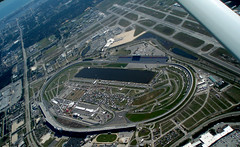 Image by NickTheIndian via Flickr
Image by NickTheIndian via FlickrDaytona International Speedway, located in Daytona Beach, Florida, is a 2.5 mile tri-oval and one of only three superspeedways on the Sprint Cup circuit. The others are Talladega Superspeedway and Pocono Raceway. Pocono is an acute triangle, a weird blend of road course and speedway. Talladega and Daytona are first cousins -- both massive tri-ovals with high-banked turns. And they were fast, too fast. Both are now restrictor plate tracks.
Restrictor plates are metal plates with holes that fit over the engine intake, restricting air flow to the engine and cutting horsepower. They're purposely trying to slow these cars down. In 1986, Bill Elliott came to Daytona and ran a qualifying lap of 210.364 mph, then ran 212.809 at Talladega, track records that still stand. But Bobby Allison spun in that Talladega race and almost went into the crowd and NASCAR decided to mandate the plates, cutting the cars' horsepower from around 750 to 430.
In a restrictor plate race the cars are going flat out -- full throttle for much or all of a lap. The cars mostly all travel in a big pack with the leader and the last place driver separated by barely a second. It's all aerodynamics. Get out of the draft (get too far behind the pack) and you'll lose so much speed that you'll soon be lapped. Get too far ahead of the pack and you're just asking for two or three cars to hook up and blow by you. Multiple cars always travel faster than lone cars.
With all the cars traveling in a pack at high speeds on the bumpy track, most restrictor plate races usually have "The Big One," a huge, multi-car, chain reaction accident. There's an on-going debate as to whether the track should be repaved to smooth it out. Dale Jr. says repave it; Edwards likes the bumps.
A trouble spot to watch is where the cars enter the backstretch off Turn Two. As the cars get into a run and the tires start to go away, drivers have to roll out of the throttle or hit the wall. Coming out of Turn 4, it's four wide that narrows down to two wide at the start/finish line.

Daytona International Speedway has 31° turns. It's 18° at the start/finish line. The backstretch is almost flat at 3°. It's wide with room for two or three lines of racing. They'll even get four wide at times. The frontstretch is 3800 feet long, the backstretch 3000. Daytona has seating for 168,000.
Speed has always been synonymous with Daytona. In the early decades of the automobile, racers started at Ormand Beach and raced toward Daytona Beach on the hard sand, attempting land speed records. When the speeds got too high to slow down before reaching the Daytona Beach boardwalk, the racers moved to the Bonneville Salt Flats for their records. Daytona next hosted a beach/road race -- partly on Highway A-1-A, partly on the beach.
Ground was broken on DIS on November 25, 1957. Bill France, NASCAR's founder, had been planning his dream track since 1953. To create the footings for the high-banked turns, dirt was taken from the infield leaving a massive hole. When the hole filled with water due to the low water table, Lake Lloyd was born.
The first race was the 1959 Daytona 500. Lee Petty and Johnny Beauchamp finished the race side-by-side. Beauchamp was declared the winner and went to Victory Lane, but after three days of reviewing photographs and newreel footage the decision was reversed and Petty was declared the official winner.
Daytona International Speedway is now a 480-acre motorsports complex -- the "World Center of Racing." There are nine major weekends of racing activity, featuring everything from NASCAR to the Rolex Sports Car Series to the American Motorcyclist Association and the World Karting Association. The racing season starts at Daytona with the 24 Hours of Daytona. The track is also used for civic and social gatherings, car shows, athletic games, photo "shoots," production vehicle testing and police motorcycle training.
The Daytona 500 Experience opened on July 5, 1996. "The Official Attraction of NASCAR" is a multi-million dollar interactive attraction that includes an IMAX Theatre, three different motion simulators, the 16-Second Pit Stop and the Daytona 500-winning car.
Dale Earnhardt holds the record for most wins at Daytona (34), but managed just one Daytona 500 win and two summer Sprint Cup wins. Richard Petty holds the record for most Daytona 500 victories (7). Jeff Gordon leads active drivers with six DIS Sprint Cup wins, three in the Daytona 500.
In February, Daytona International Speedway hosts the Bud Shootout, an exhibition race that opens the NASCAR season. The Gatorade Duel races set the field for the Daytona 500. "The Great American Race" opens the 36-race Sprint Cup season. The Nationwide Series and the Camping World Truck Series also begin their seasons in February at Daytona.
In August, there is another Nationwide race and a night-time Sprint Cup race, the Coke Zero 400.
Daytona Cup race winners
NASCAR tracks index

![Reblog this post [with Zemanta]](http://img.zemanta.com/reblog_e.png?x-id=2d7948e4-fd88-414f-83cb-b7c93793212c)
No comments:
Post a Comment